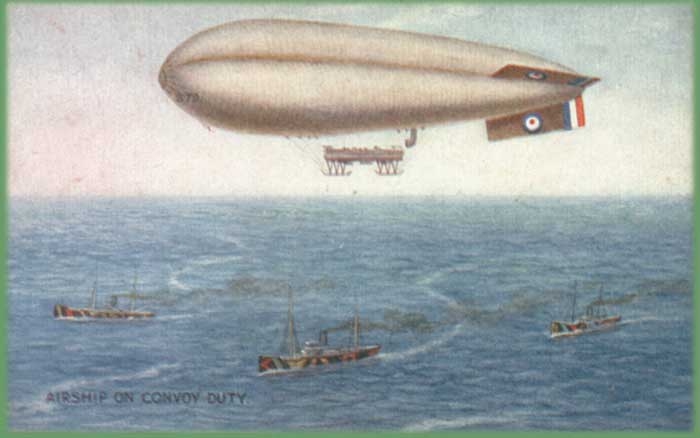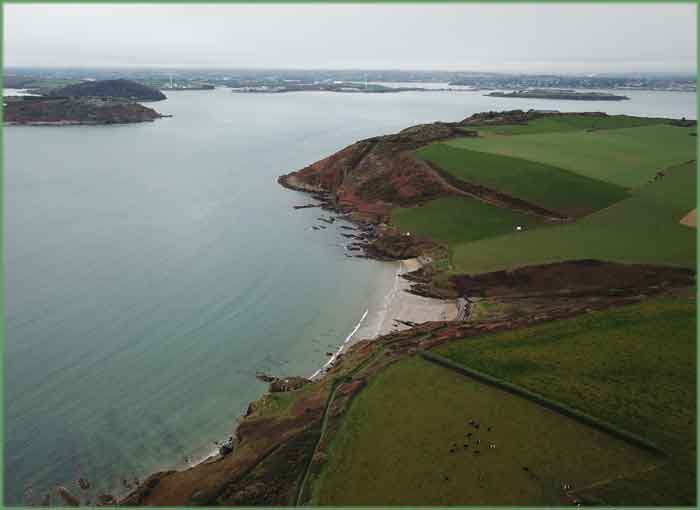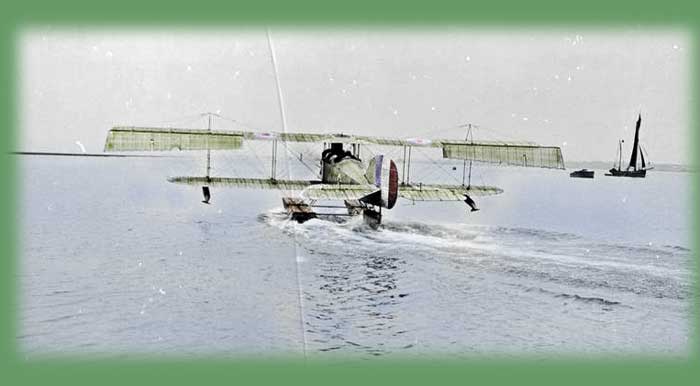

Naval aviation was virtually untried at the beginning of World War One. In previous wars, the observation balloon had been used to varying degrees of success on land. The advent of submarine warfare, meant that the ability to observe patrolling submarines, report their location, and attack them, was of primary importance.
The lighter than air airship, partially met these needs, but they were limited in that they lacked the speed of heavier than air aircraft, were very susceptible to heavy winds and needed large heavily-staffed fixed bases, as well as mooring-out stations

Contemporary postcard of 'Sea Scout' type airship escorting convoy
The initial soloution was to use land planes, from bases in England and Belgium. This was of use in the short seas such as the English Channel, but more remote areas such as the Mediterranean, and the western Atlantic coasts needed another way. The next idea was to use seaplanes from mobile bases, which were converted merchant ships
In 1914, three cross-channel steameers were taken over and converted to seaplane carriers. They were fitted out with hangers, workshops accomodation, and facilities for raising and lowering seaplanes
The Empress was a French Cross-Channel steamer, considered ideal for the task due to her relatively high top speed of about 20 knots
The Empress initially saw action in the first ever ship -launched seaplane attack, when 9 seaplanes were launched in December 1914 against Zeppelin sheds at Cruxhaven. The raid was not a military success, but showed the German forces that they were vulnerable to attack from the sea. One of the aircraft crew on this raid was flight Lieutenant Erskine Childers

The south west Atlantic approaches were particularly vulnerable to submarine attack, and were on one of the primary routes for cross- Atlantic shipping
The Vice-Admiral Commanding, Coast of Ireland Station was Lewis Bayley. He had been pleading with the Admiralty to expand his forces in the hunt for submarines, and was struggling to attain success with the forces at his disposal
He had a fleet of minesweeping trawlers and drifters, motor boats, and a few of the new sloops in his command, but badly wanted to have a force of destroyers to enhance submarine- hunting , but was informed that these were needed in the channel and elsewhere.
The sinking of the Cunarder Lusitania, off the Old Head of Kinsale, in May 1915, reinforced how vulnerable shipping was in this area
Commodore Murray Sueter, Director of the Air Department, was a prime believer in the ablities of airpower and in July 1915, proposed that HMS Empress be sent to Cork, Ireland, to become a mobile flying boat base, under the command of Vice-Admiral Bayley
"This ship to act as a floating seaplane base with Headquarters at Queenstown, her seaplanes being used in conjunction with the patrol flotilla for detection of enemy submarines. If approved it is proposed to arrange for a few temporary stations along the coast where the seaplanes could be beached" (Commodore Seuter, July 1915).
On the 12th of August 1915, HMS Empress , with a crew of about 200, and four seaplanes, arrived in Cork Harbour. There was no fanfare on its arrival, as Vice Admiral Bayley had ordered a complete news black-out on the presence of this ship and her planes. This ban was most effective, reinforced under the Defence of the Realm Act , and the presence of the ship and her aircraft was never recorded in any contemporary media reports.

The Shorts 830. Four of these type were carried on board HMS Empress
In the following two months, Empress instituted a seires of one to three day patrols, voyaging as far as Lundy Island to the East to the Fastnet on the SW of Ireland. Each day, weather permitting - one to three aircraft were launched for flights of up to two hours.
On the 4th of September Empress patrolled west and launched aircraft off the Fastnet. She received signals asking for assistance to steamer Hesperian torpedoed in position 50.02N 10.00W. She arrived at position 22.00hrs. Picked up 430 survivors of the sinking ship and arrived at Deepwater Quay, Queenstown on the 5th of September.
Patrols resumed until late October. On Tuesday 19th Oct she left Cork Harbour and Launched 3 planes on a search. The Sloop HMS Begonia had reported sighting a periscope. Nothing was found and Vice Admiral Bayley reported it as a false alarm.

White Bay, in Cork Harbour
From Late October to the 8th of December, Empress barely ventured out of Cork Harbour. Typically she would leave No4 buoy, in Queenstown Roads, each morning, anchor in White Bay, near Roches Point. The Empress would then launch and recover aircraft from there, then returning to No4 buoy each evening. Anchoring in White Bay, probably served a twofold purpose, it provided calm water for launch and recovery of aircraft within the harbour. The location was also under the protection of the guns of Fort Camden and Fort Carlisle.
From the 11th to the 17th of December Empress was refitting in Haulbowline.
She left the Queenstown Command on the 18th of December for Devonport.

